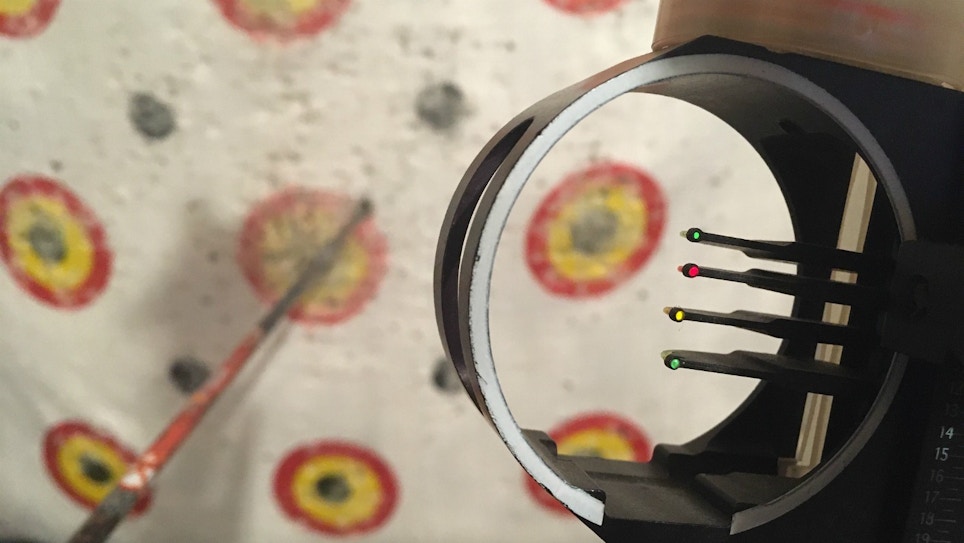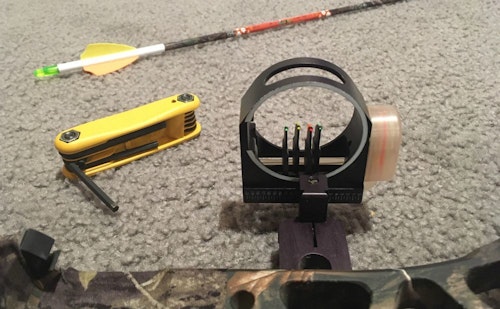During the past 45 years, I’ve helped many new archers learn how to shoot with the aid of bowsight pins. In every case, I’ve been asked, “How do you know which way to move the pins?”
My answer has always been the same: “Remember to chase the arrow.” That means you should move your bowsight pin in the direction of your arrow impact — i.e. in the direction of your miss.
For example, let’s say I’m setting up a new bow or bowsight, and from the close range of 5 yards, my first arrow impacts the target 10 inches high and 4 inches left of a baseball-sized bull’s-eye. I like to fix one problem at a time, so I begin with height.
I move my top pin up — I chase the arrow, which hit 10 inches high. How far do I raise the pin? There’s no way to give you a precise answer because too many factors are involved, but in general, a lot. I start by moving the top pin a half-inch higher and then shooting another arrow from 5 yards, aiming carefully for the center of the bull’s-eye and concentrating on making a good release, which means not punching the trigger, and following-through until the arrow hits the target. Tip: If you don’t have an Allen wrench tool for making bowsight adjustments, purchase one. The model I own is made by Pine Ridge Archery ($10.50).
After moving the top pin, let’s say arrow No. 2 from 5 yards hits 4 inches high. Again, I move the top pin higher, this time about a quarter-inch. I keep moving the pin (up or down as needed) until my arrows are in line vertically with the bull’s-eye.
Next, I attack the 4-inches-left problem. I move the bowsight pin about a quarter-inch left; I chase the arrow miss. Again, this correction amount is a guess.
From 5 yards, I carefully shoot another arrow. Let’s say I’m now hitting two inches right of the bull’s-eye. That means I overcorrected with my first guess of moving the pin a quarter inch. In this case, I move the pin right — chase the arrow; chase the miss — about an eighth inch. Chances are good that my next arrow will strike somewhere in the baseball-sized bull’s-eye from 5 yards.

Of course, this is just the beginning of the sight-in process. Because I like to set my pins for 15, 25 and 30 yards (three-pin bowsight), and add 35 yards and 40 yards for four- and five-pin bowsights, respectively, I’ll step out to 15 yards and begin the sight-in process again for my top pin. With my arrows striking the bull’s-eye from 5 yards, there’s no danger of missing the target and losing an expensive arrow from 15 yards. My arrow will strike somewhere near the bull’s-eye, and then I’ll fine tune my arrow impact by making smaller top pin adjustments vertically and horizontally on my bowsight.
After I have my 15-yard pin is dialed in, there’s a shortcut for setting my second pin (25 yards). I walk out to 25 yards, and aim for the center of the bull’s-eye with my 15-yard pin. I carefully shoot an arrow. Of course, it will strike low on the target, probably 3 to 6 inches below the bull’s-eye. Without retrieving the arrow, and still standing 25 yards from the target, I raise my 15-yard pin to the bull’s-eye and hold my bow as if I were shooting. (No need to draw, however.) I look to see where the arrow is impacting the target; on my bowsight, it will be about a quarter inch or so below the 15-yard pin. I move the 25-yard pin so it covers this arrow impact and then test it with additional arrows.







